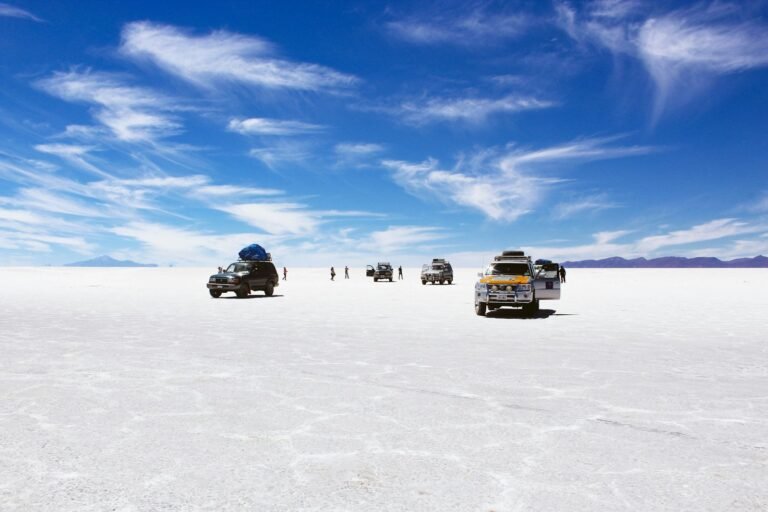Bolivia Travel Guide: Explore Nature, Culture & Hidden Gems
Welcome to the Heart of South America
Imagine standing on a mirror-like salt flat that stretches to infinity, hiking through surreal lunar valleys, or exploring ancient cities high in the Andes. Bolivia is one of South America’s most enchanting and underrated travel destinations, offering raw beauty, rich culture, and unmatched adventure.
Whether you’re a thrill-seeking backpacker, a culture-curious explorer, or a digital nomad craving off-the-grid inspiration, Bolivia delivers a truly immersive experience. In this guide, you’ll uncover the best places to visit, top things to do, when to go, local secrets, and practical travel tips to make the most of your Bolivian journey.

Destination Overview & Key Regions
Bolivia’s geography is as diverse as its culture. From the Andean peaks to the Amazon jungle, here’s how to explore the country’s distinct regions:
La Paz & El Alto
- La Paz: A chaotic, high-altitude capital set in a canyon, known for its culture, nightlife, and stunning cable cars.
- El Alto: Home to colorful street markets and a strong Indigenous Aymara presence.
Must-stay: Sopocachi for boutique stays and cultural access.
Uyuni & the Altiplano
- Gateway to the Salar de Uyuni, volcanic landscapes, geysers, and flamingo-dotted lagoons.
Must-stay: Uyuni town or a salt hotel for early morning tours.
Sucre
- Bolivia’s whitewashed constitutional capital offers charm, museums, and a spring-like climate year-round.
Must-stay: Historic center for colonial ambiance.
Santa Cruz
- Lowland city with warm weather, modern comforts, and easy access to the Amazon.
Must-stay: Equipetrol for upscale dining and nightlife.
Top Places to Visit in Bolivia
Salar de Uyuni
The world’s largest salt flat is surreal and magical—visit during the wet season (Jan–Mar) for its mirror effect.
Book a Salar de Uyuni 3-Day Tour
La Paz Cable Cars (Mi Teleférico)
Soar above the city in the world’s highest cable car system with views of snowcapped Illimani.
Valle de la Luna (Moon Valley)
Just outside La Paz—an otherworldly landscape with eroded clay spires and epic sunset views.
Lake Titicaca & Isla del Sol
Explore South America’s largest lake and its mythical birthplace of the Inca sun god.
Madidi National Park
Incredible biodiversity—jungle treks, river wildlife tours, and eco-lodges in the Amazon Basin.
Best Time to Visit Bolivia
- Dry Season (May–October): Ideal for hiking, salt flats tours, and clear mountain views.
- Wet Season (November–April): Lush landscapes, mirror effect on salt flats, but more rain.
Festivals to Experience
- Carnaval de Oruro (February): UNESCO-recognized, vibrant folkloric dances and parades.
- Alasitas Festival (January): Aymara tradition where locals buy miniatures of their wishes.
Pro Tip: Visit Uyuni in March for a chance to see the salt flats both dry and mirrored.
Top Things to Do in Bolivia
- Trek the Cordillera Real with glaciers and turquoise lakes.
- Shop and people-watch at El Alto’s 16 de Julio Market.
- Take a death-defying bike ride down Death Road (Yungas Road).
- Join a cooking class in Sucre to learn local recipes.
- Stargaze in the desert near Uyuni.
Explore Bolivia Outdoor Activities
Bolivia Travel Guide Culture & History
- Tiwanku Ruins: Pre-Inca civilization with massive stone monuments.
- Wiphala Flag: A symbol of Indigenous unity—seen across markets and protests.
- Coca Leaf Rituals: Used for altitude and spiritual ceremonies; still integral to daily life.
Bolivia remains deeply rooted in Indigenous identity, with over 30 native languages spoken and vibrant traditional clothing still widely worn.
Beaches, Nature & Outdoor Experiences
- Salar de Uyuni: Camp under the stars or visit cactus-studded Isla Incahuasi.
- Amboró National Park (Santa Cruz): A haven for birdwatchers and jungle trekkers.
- Eduardo Avaroa Reserve: Mars-like landscapes, red lagoons, and active geysers.
Best time to hike: May–September for dry trails and clear skies.
How to access: Most parks can be reached via tours from La Paz or Santa Cruz.
Viewpoints & Photo Opportunities
- Killi Killi Viewpoint (La Paz): Best cityscape shots with Illimani in the backdrop.
- Mirador de Sucre: Watch the sunset over white colonial rooftops.
- Uyuni Sunset: Golden-hour photos reflecting off the salt flats.
- Death Road Viewpoints: Dramatic drops and lush valleys—go with a guide for safety.
Bring: A drone (where allowed), tripod, warm layers, and a polarizing filter.
Local Food & Drink Bolivia Travel Guide
Must-Try Dishes
- Salteñas: Bolivian baked empanadas with sweet-spicy filling.
- Silpancho: Rice, beef, fried egg, and salsa.
- Sopa de Maní: Peanut-based soup, hearty and flavorful.
Where to Eat
- Mercado Central (Sucre): Affordable, delicious local meals.
- Gustu (La Paz): High-end Bolivian fusion by a former Noma chef.
- Café Vida (La Paz): Vegetarian and health-conscious in Sopocachi.
Optional: Book a Food Tour in La Paz
Getting There & Getting Around
- Main Airports: El Alto (La Paz), Viru Viru (Santa Cruz).
- Domestic Flights: Amaszonas and EcoJet cover most routes.
Bolivia Travel Guide Local Transport
- Mi Teleférico: Efficient and scenic in La Paz.
- Trufis (shared taxis): Common in cities.
- Buses: Inexpensive but long rides—go for trusted companies like Todo Turismo.
Apps to download: Maps.me, Moovit, and WhatsApp for tour coordination.
Safety Tip: Avoid late-night bus departures where possible.
- Torotoro National Park: Dinosaur footprints, caves, and canyons.
- Samaipata: A laid-back mountain town with pre-Inca ruins and waterfalls.
- Sajama National Park: Bolivia’s highest peak and hot springs under the stars.
- Bolivia’s wine country—yes, Bolivia makes wine.
These spots offer rich rewards for travelers willing to go beyond the main trail.
Custom Experiences & Safety Tips
- Private Salar Tours: Custom 4×4 trips with luxury camp options.
- Cholita Wrestling in El Alto: A bold mix of sport, theatre, and feminism.
- Spiritual Retreats: Experience Andean ceremonies or Ayahuasca (with licensed shamans only).
Safety Tips
- Altitude sickness is real—acclimatize slowly and hydrate.
- Beware of petty theft in crowded markets.
- Only use licensed guides and tour operators.
Nearby Destinations & Add-On Trips
- Peru: Cross Lake Titicaca by boat or bus.
- Chile: Continue your salt flat adventure into Chile’s desert.
- Cochabamba: The culinary heart of Bolivia with excellent street food.
- Amazon Tours from Rurrenabaque: Budget-friendly jungle access.
How to get there: Buses, local flights, or organized transfers are widely available.
Bolivia Travel Guide Practical Tips
Bolivia is perfect for travelers seeking raw landscapes, Indigenous heritage, and immersive adventures. It’s not always an easy destination—but it’s always rewarding.
Before You Go Checklist
- Travel insurance (covering altitude and adventure sports)
- Yellow fever certificate if visiting jungle areas
- Download offline maps and Spanish phrases
- Pack layers for altitude swings
Ready to explore Bolivia? Start by booking your first Bolivian tour here and unlock the wild soul of South America.








